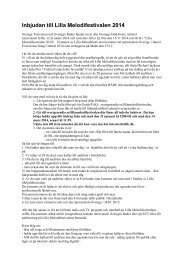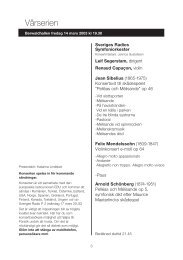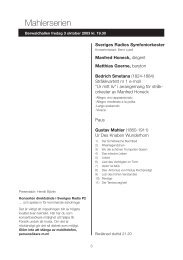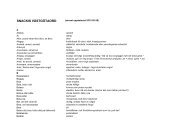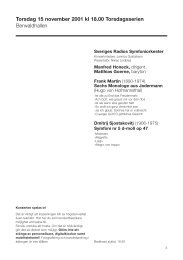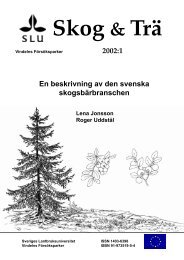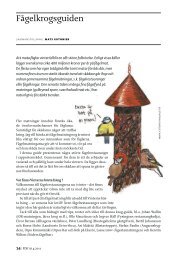SEMF 2013 Festivalprogram (pdf) - Sveriges Radio
SEMF 2013 Festivalprogram (pdf) - Sveriges Radio
SEMF 2013 Festivalprogram (pdf) - Sveriges Radio
You also want an ePaper? Increase the reach of your titles
YUMPU automatically turns print PDFs into web optimized ePapers that Google loves.
Tisdag 4 juni<br />
Tuesday 4 June<br />
Onsdag 5 juni<br />
Wednesday 5 June<br />
Torsdag 6 juni<br />
Thursday 6 June<br />
chockerande effekt. Från den första madrigalboken, som präglas<br />
av ungdomlighet, till den mognad man finner i den femte boken,<br />
har Monteverdi ständigt omdefinierat sin relation till poeten för<br />
att slutligen blanda musik och text i den dramatiska perfektion<br />
som är Orfeo. Opera i sin sannaste form föddes, men dess källa<br />
madrigalen skulle aldrig komma att återfå sin ställning.<br />
EFTER EN TEXT AV PAUL AGNEW<br />
After an 11 year wait between the publications of his Third Book of<br />
Madrigals (1592) and his Fourth (1603), Monteverdi does not hesitate<br />
to publish his Fifth Book only two years later in 1605. The speed<br />
of publication of this new collection is explained by the fact that much<br />
of the material contained in both the Fourth and Fifth Books had<br />
circulated in manuscript form throughout the previous decade. This<br />
makes the Fifth Book a curious compendium of early and more recent<br />
compositions, some dating back to the mid 1590s, others clearly<br />
demonstrations of his most modern techniques.<br />
les arts florissants, foto: marie-emmanuelle brétel<br />
The defining event in Mantua between the publication of the Third<br />
Book in 1592 and the Fifth Book in 1605 was perhaps the performance<br />
of Guarini’s epic poem ’Il Pastor Fido’ in 1598 – a performance<br />
that had a strong and lasting influence on the court’s cultural life. In<br />
Monteverdi’s Fifth Book there are no less than 16 settings of Guarini.<br />
More than half the book is concerned directly with passages from ’Il<br />
Pastor Fido’. Monteverdi’s dramatic instincts have developed to a new<br />
height, and the dramatic force, perhaps influenced by the experience<br />
of the 1598 staging, has gained a new intensity which will ultimately<br />
be perfected in the extraordinary five-part setting of Ariadne’s lament<br />
that opens the Sixth Book (1614).<br />
Already in 1607, however, Monteverdi will change the face of music<br />
history with his creation of ‘Orfeo’. Through the intensity of his<br />
research into the dramatic potential of harmony to portray the most<br />
intricate of emotions within the text in his Fifth Book of Madrigals,<br />
Monteverdi is able to produce a work of great subtlety and power,<br />
transforming monody from its dilettante beginnings into an art of<br />
shocking impact. Monteverdi has served an unconscious apprenticeship<br />
from his youthful First Book of Madrigals until his mature Fifth<br />
Book, constantly redefining his relationship with the poet, finally to<br />
blend music and word into the dramatic perfection that is Orfeo.<br />
Opera in its truest form is born, but, inevitably, the madrigal, which<br />
has been its source, will never recover.<br />
FROM A TEXT BY PAUL AGNEW<br />
8



